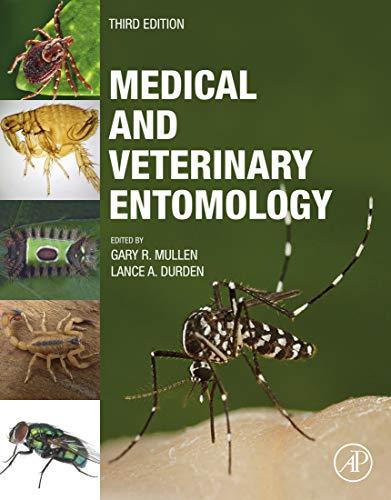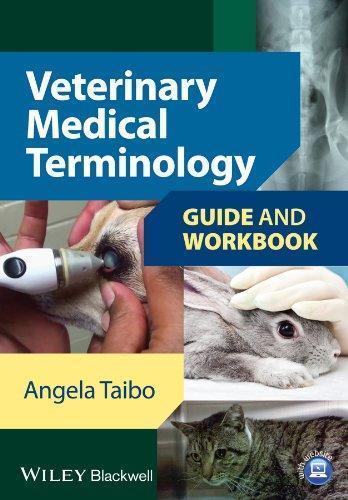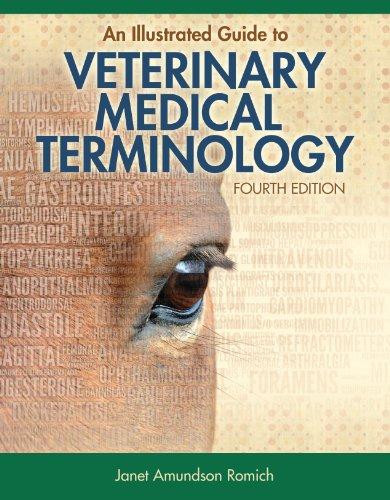Visit to download the full and correct content document: https://ebookmass.com/product/medical-and-veterinary-entomology-3rd-edition-ebook -pdf/
More products digital (pdf, epub, mobi) instant download maybe you interests ...
Medical and Veterinary Entomology 3rd Edition
https://ebookmass.com/product/medical-and-veterinaryentomology-3rd-edition/
Veterinary Medical Terminology: Guide and Workbook 1st Edition – Ebook PDF Version
https://ebookmass.com/product/veterinary-medical-terminologyguide-and-workbook-1st-edition-ebook-pdf-version/
Introduction to Veterinary Science 3rd Edition, (Ebook PDF)
https://ebookmass.com/product/introduction-to-veterinaryscience-3rd-edition-ebook-pdf/
Color Atlas of Veterinary Histology 3rd Edition, (Ebook PDF)
https://ebookmass.com/product/color-atlas-of-veterinaryhistology-3rd-edition-ebook-pdf/
Entomology and Pest Management 6th Edition – Ebook PDF Version
https://ebookmass.com/product/entomology-and-pest-management-6thedition-ebook-pdf-version/
Veterinary Dentistry: A Team Approach 3rd Edition –Ebook PDF Version
https://ebookmass.com/product/veterinary-dentistry-a-teamapproach-3rd-edition-ebook-pdf-version/
Fundamentals of Medical Imaging 3rd Edition, (Ebook PDF)
https://ebookmass.com/product/fundamentals-of-medicalimaging-3rd-edition-ebook-pdf/
Understanding and Applying Medical Anthropology 3rd Edition u2013 Ebook PDF Version
https://ebookmass.com/product/understanding-and-applying-medicalanthropology-3rd-edition-ebook-pdf-version/
An Illustrated Guide to Veterinary Medical Terminology (MindTap Course List) 4th Edition – Ebook PDF Version
https://ebookmass.com/product/an-illustrated-guide-to-veterinarymedical-terminology-mindtap-course-list-4th-edition-ebook-pdfversion/
10.
Fleas(Siphonaptera)
LanceA.DurdenandNancyC.Hinkle
11. Flies(Diptera)
ReidR.GerhardtandLawrenceJ.Hribar
ScuttleFlies)
Ctenocephalidesfelis)
Ctenocephalidescanis)
Xenopsyllacheopis)
Spilopsylluscuniculi)
SticktightFlea(Echidnophagagallinacea) 152 Chigoe(Tungapenetrans)
NorthernRatFlea(Nosopsyllusfasciatus)
12. PhlebotomineSandFliesandMoth Flies(Psychodidae)
LeonardE.Munstermann
15. Mosquitoes(Culicidae)
WoodbridgeA.FosterandEdwardD.Walker
13. BitingMidges(Ceratopogonidae)
GaryR.MullenandC.StevenMurphree
14.
BlackFlies(Simuliidae)
PeterH.AdlerandJohnW.McCreadie
16. HorseFliesandDeerFlies (Tabanidae)
Elaeophorosis 340
OtherPathogensofVeterinaryImportance 340
PreventionandControl 340
ReferencesandFurtherReading 341
17. MuscidFlies(Muscidae)
RogerD.Moon
Taxonomy 345
Morphology 346
LifeHistory 350
BehaviorandEcology 351
SpeciesofMedical-VeterinaryImportance 353
HouseFly(Muscadomestica) 353
BazaarFly(Muscasorbens) 354
BushFly(Muscavetustissima) 354
FaceFly(Muscaautumnalis) 354
ClusterFly(Polleniarudis) 354
StableFly(Stomoxyscalcitrans) 354
HornFly(Haematobiairritansirritans)and BuffaloFly(Haematobiairritansexigua) 355
FalseStableFly (Muscinastabulans)andIts Relatives 355
LittleHouseFly(Fanniacanicularis)andIts Relatives 355
GarbageFlies(Hydrotaea spp.) 356
SweatFlies(Hydrotaea spp.) 356
BirdNestParasites(Passeromyia spp., Philornis spp.,and Protocalliphora spp.) 356
PublicHealthImportance 356
HouseFly(Muscadomestica) 357
BazaarFly(Muscasorbens) 357
BushFly(Muscavetustissima) 358
FaceFly(Muscaautumnalis)andClusterFly (Polleniarudis) 358
StableFly(Stomoxyscalcitrans) 358
FalseStableFly(Muscinastabulans)andIts Relatives 359
LittleHouseFly(Fanniacanicularis)andIts Relatives 359
GarbageFlies(Hydrotaea spp.) 359
SweatFlies(Hydrotaea spp.) 359
VeterinaryImportance 359
HouseFly(Muscadomestica) 360
BushFly(Muscavetustissima) 360
FaceFly(Muscaautumnalis) 361
StableFly(Stomoxyscalcitrans) 362
HornFly(Haematobiairritansirritans)and BuffaloFly(Haematobiairritansexigua) 363
SweatFlies(Hydrotaea spp.) 364
BirdNestParasites(
spp.)
18. TsetseFlies(Glossinidae)
19. Myiasis(Muscoidea,Oestroidea)
PhilipJ.Scholl,DouglasD.Colwell,and Ramo´nCepeda-Palacios
Syrphidae(FlowerFlies,HoverFlies, Rat-TailedMaggots)
FruitFlies,andWineFlies)
FrogFlies)
Calliphoridae(BlowFlies,CarrionFlies, FloorMaggots,NestMaggots,and Screwworms)
NewWorldSkinBotFlies(Cuterebrinae) 403
StomachBotFlies(Gasterophilinae)
20. LouseFlies,Keds,andBatFlies
(Hippoboscoidea)
WillK.ReevesandJohnE.Lloyd
22. Ants,Wasps,andBees (Hymenoptera)
21. MothsandButterflies(Lepidoptera)
GaryR.MullenandJenniferM.Zaspel
23. Scorpions(Scorpiones)
24. Solpugids(Solifugae)
GaryR.Mullen
25. Spiders(Araneae)
GaryR.MullenandRichardS.Vetter
26. Mites(Acari)
GaryR.MullenandBarryM.OConnor
556
Listrophoridae 566 Atopomelidae 567 Chirodiscidae 567 Myocoptidae 567 FeatherMites 568 MangeMites 568 Laminosioptidae 571 Demodecidae 572
Psorergatidae 574
Sarcoptidae 575
OtherSarcoptidGenera 578 Rhyncoptidae 580
Psoroptidae 581
PsoropticScabMites 581
ChoriopticScabMites 583
CaparinicScabMites 584
Harpirhynchidae 585 Hypoderatidae 585
Ereynetidae 590
Trombiculidae,Leeuwenhoekiide,and Walchiidae 591
27. Ticks(Ixodida)
WilliamL.Nicholson,DanielE.Sonenshine, BruceH.Noden,andRichardN.Brown
28. MolecularToolsUsedinMedical andVeterinaryEntomology
PosttranscriptionalGeneSilencingWith RNAi 689 ConclusionsandFutureDirections 689 ReferencesandFurtherReading 691
Thispageintentionallyleftblank
Contributors
PeterH.Adler,DepartmentofPlantandEnvironmental Sciences,ClemsonUniversity,Clemson,SC,United States
ChristopherM.Barker,CenterforVectorborneDiseases, SchoolofVeterinaryMedicine,UniversityofCalifornia, Davis,CA,UnitedStates
RichardJ.Brenner,Director,ATIPFoundation,Arlington, TX,UnitedStates;FormerlyAssistantAdministratorof TechnologyTransfer,USDA,AgriculturalResearch Service,Beltsville,MD,UnitedStates
RichardN.Brown,DepartmentofWildlife,Humboldt StateUniversity,Arcata,CA,UnitedStates
NathanD.Burkett-Cadena,UniversityofFlorida,Florida MedicalEntomologyLaboratory,VeroBeach,FL, UnitedStates
RamónCepeda-Palacios,AnimalScienceandEnvironmentalConservationDepartment,AutonomousUniversityofBajaCaliforniaSur,LaPaz,Mexico
DouglasD.Colwell,LivestockParasitology,Agriculture andAgri-FoodCanada,LethbridgeResearchand DevelopmentCentre,Lethbridge,AB,Canada
LanceA.Durden ,DepartmentofBiology,Georgia SouthernUniversity,Statesboro,GA,UnitedStates
WoodbridgeA.Foster,DepartmentofEvolution,Ecology,andOrganismalBiology,andDepartmentof Entomology,TheOhioStateUniversity,Columbus, OH,UnitedStates
RebeccaTroutFryxell,DepartmentofEntomologyand PlantPathology,UniversityofTennessee,Knoxville, TN,UnitedStates
ReidR.Gerhardt,DepartmentofEntomologyandPlant Pathology,UniversityofTennessee,Knoxville,TN, UnitedStates
NancyC.Hinkle,DepartmentofEntomology,University ofGeorgia,Athens,GA,UnitedStates
LawrenceJ.Hribar,FloridaKeysMosquitoControl District,Marathon,FL,UnitedStates
JonasG.King,DepartmentofBiochemistry,Molecular Biology,EntomologyandPlantPathology,Mississippi StateUniversity,Starkville,MS,UnitedStates
RichardD.Kramer,BoardCertifiedEntomologist(BCE), CEOInnovativePestManagement,Inc.,Brookeville, MD,UnitedStates
WilliamL.Krinsky,DivisionofEntomology,Peabody MuseumofNaturalHistory,YaleUniversity,New Haven,CT,UnitedStates
PeterJ.Landolt,TemperateTreeFruitandVegetable Research,USDAARS,Wapato,WA,UnitedStates
JohnE.Lloyd,DepartmentofRenewableResources, UniversityofWyoming,Laramie,WY,UnitedStates
JohnW.McCreadie,DepartmentofBiologicalSciences, UniversityofSouthAlabama,Mobile,AL,UnitedStates
RogerD.Moon,DepartmentofEntomology,Universityof Minnesota,St.Paul,MN,UnitedStates
GaryR.Mullen,DepartmentofEntomologyandPlant Pathology,AuburnUniversity,Auburn,AL,United States
BradleyA.Mullens,DepartmentofEntomology,UniversityofCalifornia,Riverside,CA,UnitedStates
LeonardE.Munstermann,YaleUniversitySchoolof PublicHealth,NewHaven,CT,UnitedStates
C.StevenMurphree,BiologyDepartment,Belmont University,Nashville,TN,UnitedStates
DanaNayduch,USDA-ARS,Arthropod-borneAnimal DiseasesResearchUnit,Manhattan,KS,UnitedStates
WilliamL.Nicholson,RickettsialZoonosesBranch, DivisionofVector-BorneDiseases,NationalCenterfor EmergingandZoonoticInfectiousDiseases,Centersfor DiseaseControlandPrevention,Atlanta,GA,United States
BruceH.Noden,DepartmentofEntomologyandPlant Pathology,OklahomaStateUniversity,Stillwater,OK, UnitedStates
BarryM.OConnor,MuseumofZoology,Universityof Michigan,AnnArbor,MI,UnitedStates
PiaUntalanOlafson,USDA-ARS,LivestockArthropod PestsResearchUnit,Kerrville,TX,UnitedStates
HalC.Reed,DepartmentofBiologyandChemistry,Oral RobertsUniversity,Tulsa,OK,UnitedStates
WillK.Reeves,U.S.DepartmentofAgriculture,Animal andPlantHealthInspectionService,Biotechnology ResourceServices,WesternComplianceAssurance Branch,FortCollins,CO,UnitedStates
WilliamK.Reisen,CenterforVectorborneDiseases, SchoolofVeterinaryMedicine,UniversityofCalifornia, Davis,CA,UnitedStates
JustinO.Schmidt,SouthwesternBiologicalInstitute, Tucson,AZ,UnitedStates;DepartmentofEntomology, UniversityofArizona,Tucson,AZ,UnitedStates
PhilipJ.Scholl,UnitedStatesDepartmentofAgriculture, AgriculturalResearchService(retired),Oxford,FL, UnitedStates
W.DavidSissom,DepartmentofLife,EarthandEnvironmentalSciences,WestTexasA&MUniversity, Canyon,TX,UnitedStates
DanielE.Sonenshine,DepartmentofBiologicalSciences, OldDominionUniversity,Norfolk,VA,UnitedStates
MichaelJ.Turell,VirologyDivision,UnitedStatesArmy MedicalResearchInstituteofInfectiousDiseases,Fort Detrick,Frederick,MD,UnitedStates(retired)
RichardS.Vetter,DepartmentofEntomology,University ofCalifornia,Riverside,CA,UnitedStates
EdwardD.Walker,DepartmentofMicrobiologyand MolecularGenetics,andDepartmentofEntomology, MichiganStateUniversity,EastLansing,MI,United States
JenniferM.Zaspel,MilwaukeePublicMuseum, Milwaukee,WI,UnitedStates
Preface
Ithasbeen10yearssincethepublicationofthesecond editionofthisbook.Signi ficantadvanceshavebeenmade inourknowledgeofaplethoraofarthropod-relatedproblemsanddiseases,includingchangesintheirgeographic rangesandtheemergenceofneworpreviouslyunrecognizedarthropod-bornediseasesofmedicalandveterinary concern.AmongnotableexamplesofthelatterareZikaand Chikungunyavirusestransmittedbymosquitoesanda numberoftick-bornepathogens,suchasBourbon,Heartland,andseverefeverwiththrombocytopeniasyndrome viruses,aswellasnewlyrecognizedformsofehrlichiosis, rickettsiosis,andbabesiosis.Anewchapterhasbeen added Chapter3:ArthropodToxinsandVenoms to provideanoverviewofthestructuralnatureanddiversity ofchemicalcompoundsthatplayanimportantmedicalveterinaryrole,particularlyamongstingingandbitinginsectsandarachnids.Inaddition,Chapter28:Molecular ToolsUsedinMedicalandVeterinaryEntomologyhas beenexpanded,reflectingthemanysigni ficantadvances andapplicationsofmolecularandgenetictechniquesin recentyears,whichhavebecomesuchanintegralpartof medical-veterinaryentomologytoday.
Oneoftheprimaryobjectivesofthe firstandsecond editionshasbeentoprovideatextbooksuitableforteachingcoursesinmedicalandveterinaryentomologyatthe collegeanduniversitylevels.Inkeepingwiththatgoaland theformatofthepreviouseditions,thebookisorganized fromanentomologicalperspective,witheachchapter devotedtoaparticulartaxonomicgroupofinsectsor arachnids(includingspiders,scorpions,solpugids,mites, andticks).Eachchapterincludesthefollowingsubheadings:Taxonomy,Morphology,LifeHistory,Behavior andEcology,PublicHealthImportance,Veterinary Importance,PreventionandControl,andReferencesand FurtherReading.Theseparatesectionsonpublichealthand veterinaryentomologyaredesignedtoassistinstructorsin usingthisbooktoteachcoursesineithermedicalorveterinaryentomology,orcoursescombiningthesetworelated disciplines.ThebookconcludeswithanAppendixtitled “Arthropod-RelatedVirusesofMedicalandVeterinary Importance” andaGlossaryofapproximately1,700terms. Thelatterisintendedtoassistthereaderinunderstanding
entomological,medical,andothertermsusedinthebook, withwhichsheorhemaynotbefamiliar.Wehopethiswill behelpfultothewidestpossiblerangeofreaders,specialistsandnonspecialistsalike,indiversedisciplines relatingeitherdirectlyorindirectlytothesubjectmatter. Thetextisillustratedwith538 figuresand22revised,or new,colormaps.
Inadditiontoitsvaluetostudentsasatextbook,this volumeisintendedforamuchbroaderaudienceasa comprehensivereferencesourceforbiologistsingeneral, entomologists,zoologists,parasitologists,physicians,publichealthpersonnel,veterinarians,wildlifebiologists, vectorbiologists,militaryandarmedforcesentomologists, thegeneralpublic,andotherslookingforareadable, authoritativesourceofinformationonthisimportanttopic.
Wewelcomeasnewcontributingauthorstothebook thefollowing14individuals:JustinO.Schmidt(Chapter3), ChristopherM.Barker(Chapter4),LawrenceJ.Hribar (Chapter11),LeonardE.Munstermann(Chapter12),C. StevenMurphree(Chapter13),DouglasD.Colwelland RamónCepeda-Palacios(Chapter19),WillK.Reeves (Chapter20),JenniferM.Zaspel(Chapter21),W.David Sissom(Chapter23),BruceH.NodenandRichardN. Brown(Chapter27),andRebeccaTroutFryxell andPiaUntalanOlafson(Chapter28).Togetherwith24 continuingauthorsofthesecondeditionandtheGraphics Editor,40contributorsinall,theyhavehelpedsignificantly inrevisingtherespectivechapters providingnew perspectivesandachievinganappropriatebalancebetween medicalandveterinaryentomologyascloselyrelated disciplines.
Thesuccessoftheprevioustwoeditionsisreflectedby thewidespreadadoptionofthisbookforteachingmedical and/orveterinary-relatedcoursesatcollegesanduniversitiesthroughouttheUnitedStatesandotherpartsofthe world.Wehopethethirdeditionwillbeequallysuccessful inhelpingtoeducateandinspirethenextgenerationof medicalandveterinaryentomologists.
GaryR.Mullen LanceA.Durden
Thispageintentionallyleftblank
Acknowledgments
Aswithanyundertakingofthismagnitude,therearemany individualstowhomtheeditorsareindebted.Foremostare thecontributingauthors,whosecombinedexpertiseand commitmenttopromotingmedicalandveterinaryentomologyhavemadethethirdeditionofthisbookpossible. Wealsooweadebtofgratitudetothemanyother individualswhocontributedsogenerouslyoftheirtimein reviewingchaptersorselectpartsofthetext,offering suggestionsforimprovingandupdatingmaterialforthe thirdedition,preparingillustrations,andprovidingoriginal photographsandnewcolorimagesforthe538 fi gures.
Weparticularlywanttorecognizethefollowingpeople whohavecontributedsignificantlyinpreparingthe figures, maps,andotherillustrationsthroughoutthebook: firstand foremost,JonasG.King(MississippiStateUniversity, Starkville,MS)forhisinvaluablegraphicsskillsandallimportantroleinensuringthehigh-qualitycolorimages andmapsthroughoutthechapters;aspecialthankstoJillian Masters,anundergraduatestudentworkingwithJonas King,forherwelcomedtalentandgeneroustimeassisting withthe figures,particularlythemaps;andgraduatestudent AnaghaGopakumar,alsoamemberoftheKinglabgroupat MississippiStateforherpartinpreparingillustrations; LorenzaBeatiandLanceA.Durden(GeorgiaSouthern University,Statesboro,GA)forpreparingthestackedimagesofthelice(Figs.7.5 7.7,7.12 7.16and7.19)and fleas(Figs.10.1,10.8 10.12,10.14,10.17 10.19and 10.21,andOrientalrat fleaonbookcover);NathanD. Burkett-Cadena(UniversityofFlorida,FloridaMedical EntomologyLaboratory,VeroBeach,FL),forprovidingthe originalcolorillustrationsthataccompanyhischapteron morphologicaladaptationsofparasiticarthropods (Figs.2.1 2.5),preparingoriginalillustrationsforthe epidemiologychapter(Figs.4.2and4.3),andproviding12 additional figuresthroughoutthebook(seebelow);E.Paul Catts(WashingtonStateUniversity,Pullman,WA),for beingabletoincludeinthisthirdeditionhissuperboriginal linedrawingsofmyiasis-causing fliesthathepreparedfor the firstedition,priortohisuntimelydeathin1996 (Figs.19.1 19.9,19.11,19.13 19.15,19.17,19.20,19.23, 19.27,19.32,19.33,19.36,19.37and19.40);Victoria Rhodes(MissouriSouthernStateUniversity,Joplin,MO), forherexcellentcolorillustrations,Chapter28,
Figs.28.1 28.4,andBoxes28.1 28.3);MargoA.Duncan (Gainesville,FL),forheroriginalillustrations,particularly thoseintheLepidopterachapter(originalFig.21.4and redrawnFigs.21.2,21.3and21.5)thatappearinthe first, second,andthirdeditions;RebeccaL.Nims(SocialCircle, GA),fortheoutstandingworkshedidinredrawingfrom varioussourcesmorethanhalftheblack-and-white figures forthe firstandsecondeditions(notablyforthemite chapter),virtuallyallofwhichhavebeenretainedinthe thirdedition;andPhilipB.Shevlin(AuburnUniversity, Auburn,AL)forhisassistancewithpreparationofthe chemicalstructuresofarthropodtoxinsandvenoms (Figs.3.3 3.8).
Wealsoacknowledgethefollowingindividualsfor preparingoriginalillustrations,primarilylinedrawings, whichappearwithinthesepages:WoodbridgeA.Foster (TheOhioStateUniversity,Columbus,OH;Fig.15.14); SusanMilnaHope(Mebane,NC;Fig.16.1);JonasG.King (MississippiStateUniversity,Starkville,MS;Figs.14.1 and18.12);TakumasaKondo(Palmira,Valle,Colombia; Fig.11.9);WilliamL.Krinsky(YaleUniversity,New Haven,CT;Figs.5.3,8.7and8.11);andBlairSampson (USDepartmentofAgriculture,AgriculturalResearch Service,Poplarville,MS;Fig.22.6).
Thefollowingindividualshavekindlyprovidedoriginal photographs,slides,ordigitalimagesforreproductionas fi guresinthisedition,orhavecontributedinvariousother ways:
W.V.Adams,Jr.(LouisianaStateUniversity,Baton Rouge,LA;Fig.16.13);PeterH.Adler(Clemson University,Clemson,SC;Fig.14.7);RogerD.Akre (WashingtonStateUniversity,Pullman,WA;Figs.22.14, 22.15,22.24and22.31);KarimAounandAïdaBouratbine (InstitutPasteurdeTunis,Tunisia;Fig.12.14);Stephen Ausmus(USDepartmentofAgriculture;Fig.22.25);Hans Bänziger(ChaingMaiUniversity,Thailand;Figs.21.19, 21.20and20.22);MartinBennett(CreativeCommons; Fig.19.21);RobertB.Berry(OrangeBreastedFalcon Project,ThePeregrineFund,Wolf,WY;Fig.17.22); YehudaBraverman(KimronVeterinaryInstitute,Israel; Fig.12.9);AlbertoB.Broce(KansasStateUniversity, Manhattan,KS);NathanD.Burkett-Cadena(Universityof Florida,FloridaMedicalEntomologyLaboratory,Vero
Beach,FL;Figs.5.1,5.4,6.4,7.9,10.4 10.7,16.3,20.6, 25.6and26.11);JoãoP.Burini(Ponti ficaUniversidade CatólicadeSãoPaulo,Brazil;Figs.23.2,23.14,25.4,25.5 and25.10);LyleBuss(UniversityofFlorida,Gainesville, FL;Fig.21.25);JerryF.Butler(UniversityofFlorida, Gainesville,FL;Figs.9.3B,20.5,21.13,25.25,26.40, 26.43and27.11);BonnieBuxton(PhiladelphiaCollegeof OsteopathicMedicine-GeorgiaCampus,Suwanee,GA; Fig.15.42);BrittanyE.Campbell(UniversityofFlorida, Gainesville,FL;Fig.8.13);LuisPauloCarvalho(Federal UniversityofRondonia-Unir,PortoVelho,Brazil; Fig.13.14);JamesCastner(UniversityofFlorida,Gainesville,FL;Figs.6.3,6.5 6.12and21.26);RonaldD. Cave(IndianRiverResearchandEducationCenter,UniversityofFlorida,FortPierce,FL;Fig.19.26);ValerieJ. Cervenka(UniversityofMinnesota,St.Paul,MN, Fig.17.23);ChanCheeKeong(PanangIsland,Malaysia; Fig.9.6);JillianCowles(Vail,AZ;Fig.3.9);DouglasA. Craig(UniversityofAlberta,Edmonton,AB,Canada; Figs.14.2Band14.3);EddieW.Cupp(Owensboro,KY; Figs.14.12and14.14);AaronT.Dossey(Gainesville, FL;Fig.1.5);S.AllenEdgar(AuburnUniversity,Auburn, AL;Figs.15.37and15.38);MarcE.Epstein(California DepartmentofFoodandAgriculture,Sacramento,CA; Fig.21.12);JohnFlannery(RichmondCounty,NC; Fig.21.1A);WoodbridgeA.Foster(TheOhioStateUniversity,Columbus,OH;Figs.15.11,15.17,15.19,15.26, 15.29and15.34);WesGaston(USDepartmentofAgriculture,AnimalandPlantHealthInspectionService, WildlifeServices;Fig.19.41);JamesL.Gathany(Centers forDiseaseControlandPrevention,Atlanta,GA;Figs.7.4, 8.3,11.2,12.2,27.5and27.17);CarolynGrissom(Shelbyville,TN;Fig.25.17);DuaneJ.Gubler(Duke-National UniversityofSingaporeGraduateMedicalSchool, Singapore;Fig.15.25);HadelH.Go(AmericanMuseumof NaturalHistory,NewYork,NY;forataxonomicclari ficationregardingtheHymenoptera);RobertG.Hancock (UniversityoftheCumberlands,Williamsburg,KY; Fig.15.23);EltonJ.Hansens(Asheville,NC;Figs.7.8, 10.20,16.7,16.10Aand17.12);MarkHarvey(Western AustraliaMuseum,Welshpool,WesternAustralia;for taxonomicinformationontheSolifugae);NancyC.Hinkle (UniversityofGeorgia,Athens,GA;Fig.9.11);Mac Horton(ClemsonUniversity,Clemson,SC;Fig.22.28); KevinHumphries(Huntsville,AL;Fig.25.16);LacyL. Hyche(AuburnUniversity,Auburn,AL;Fig.21.15); GregoryD.Johnson(MontanaStateUniversity,Bozeman, MT;Fig.7.20);JenaJohnson(JenaJohnsonPhotography andUniversityofGeorgia,Athens,GA;Figs.14.1,14.5, 14.6,22.13and22.20;book-coverimages,Asiantiger mosquitoandgreen-bottle fly);FlorianKarolyi(University ofVienna,Austria;Fig.16.4);TakumasaKondo(Palmira, Valle,Colombia;Fig.22.23);WilliamL.Krinsky(Yale University,NewHaven,CT;Figs.5.2,5.5and8.6);
RichardC.Lancaster(AgricultureandAgri-FoodCanada, Lethbridge,AB;Fig.13.2);LloydL.Lauerman(Alabama StateVeterinaryDiagnosticLaboratoryAuburn,AL; Figs.13.10 13.12);MatthewS.Lehnert(KentStateUniversityatStark,NorthCanton,OH;Figs.21.1B,Cand 21.24);JohnE.Lloyd,Sr.(UniversityofWyoming,Laramie,WY;Figs.7.19,7.21,20.3,20.8and20.12 20.14); AmandaD.Loftis(RossUniversitySchoolofVeterinary Medicine,Basseterre,SaintKitts,WestIndies;Fig.20.1); StephenA.Marshall(UniversityofGuelph,Guelph,ON, Canada;Figs.13.1,14.2Aand14.4);SturgisMcKeever (GeorgiaSouthernUniversity,Statesboro,GA;Figs.16.5, 19.18,21.6 21.10,21.14,21.18and25.21,andsaddleback caterpillaronbookcover);MaeMelvin(CentersforDiseaseControlandPrevention,Atlanta,GA;Fig.8.8);HendrickJ.Meyer(NorthDakotaStateUniversity,Fargo,ND; Fig.17.25);CamilleMeyers(CourtesyofPeregrine Fund;Fig.17.22);SteveMihok(Russell,ON,Canada; Fig.16.10D);RogerD.Moon(UniversityofMinnesota,St. Paul,MN;Figs.17.16and17.19);GaryR.Mullen(Auburn University,Auburn,AL;Figs.8.16,9.3A,13.5,13.6, 13.13,13.14,17.18,17.20,19.19,21.11,22.9,22.19, 22.21,22.22,22.29,22.30,25.13and27.9);BradleyA. Mullens(UniversityofCalifornia,Riverside,CA; Figs.16.8and16.10B);TeresaR.Mullens(Riverside,CA; Fig.16.10C);LeonardE.Munstermann(YaleUniversity, NewHaven,CT;Figs.12.5 12.8and12.10);AmyC. Murillo(UniversityofCalifornia,Riverside,CA; Figs.7.17A F,7.22,10.13and26.25);HaroldD.Newson (MichiganStateUniversity,EastLansing,MI;Figs.15.39 and15.41);WilliamL.Nicholson(CentersforDisease ControlandPrevention,Atlanta,GA;Fig.27.10;SusanM. Noh(USDepartmentofAgriculture,Pullman,WA;Fig. 27.30);YoshiroOhara(KanazawaMedicalUniversity, Uchinada,Ishikawa,Japan;Fig.16.12);ChristopherD. Paddock(CentersforDiseaseControlandPrevention, Atlanta,GA;Figs.27.22and27.23);JonathanD.Patterson (MichiganStateUniversity,EastLansing,MI;Fig.15.40); LaverneL.Pechuman(CornellUniversity,Ithaca,NY; Fig.16.6);NicholasPerrault(CreativeCommons; Fig.14.8);EricPoggenphol(EricPoggenpholPhotography,Northampton,MA;Fig.14.13);LorenzoPrendini (AmericanMuseumofNaturalHistory,NewYork;forhis contributedexpertiseonscorpions);RobertJ.Raven (QueenslandMuseum,SouthBrisbane,Australia; Fig.25.9);CharlesRay(AuburnUniversity,AUPlant DiagnosticLaboratory,Auburn,AL;forprovidingrecords ofinsectsandmitesbitinghumans);DavidE.Reed (Chanhassen,MN;Fig.9.4);HalC.Reed(OralRoberts University,Tulsa,OK;Figs.22.2,22.5,22.10,22.16and 22.18);LawrenceE.Reeves(UniversityofFlorida,Gainesville,FL;Fig.19.24);JonRichfield(CreativeCommons; Fig.24.1);MaryElizabethHayesRogers(Waukegan,IL; Fig.13.18);ChristopherSaski(ClemsonUniversity,
GenomicsandComputationalLaboratory,Clemson,SC; forhisreviewandeditorialsuggestions,Chapter28);Philip J.Scholl(USDepartmentofAgriculture,Agricultural ResearchService,Oxford,FL;Fig.19.35);JustinO. Schmidt(USDepartmentofAgriculture,CarlHaydenBee ResearchCenter,Tucson,AZ;Fig.22.27);JosephA. Schemanchuk(DepartmentofAgricultureandAgri-Food Canada,Lethbridge,AB,Canada;Figs.14.15and14.16); D.CraigSheppard(UniversityofGeorgia,Athens,GA; Fig.17.21);W.DavidSissom(WestTexasA&MUniversity,Canyon,TX;Figs.23.1,23.2,23.6,23.9and 23.10 23.13,andscorpiononbookcover);RachelStone (WichitaStateUniversity,Wichita,KS;Fig.9.9);DanielR. Suiter(UniversityofGeorgia,Grif fin,GA;Fig.6.2); RobertB.Tesh(UniversityofTexasMedicalBranch, Galveston,TX;Fig.8.5);GerritUilenberg(Corsica, France;Figs.27.28,27.29,27.31and27.32);Richard Urbanek(USFishandWildlifeService;Figs.14.7and 14.8);RichardS.Vetter(UniversityofCalifornia,Riverside,CA;Figs.25.12,25.15,25.19and25.20);P.Kirk Visscher(UniversityofCalifornia,Riverside,CA; Fig.13.7);JanVotýpka(CzechAcademyofScience, CzechRepublic;Fig.14.19);LaurelL.Walters(LieenFollicanResearch,Bishop,CA;Fig.12.13);WesleyD. Watson(UniversityofNorthCarolina,Raleigh,NC; Fig.9.10);JerryWeintraub(AgricultureandAgri-Food Canada,Lethbridge,AB;Figs.19.28and19.31);Julian White(ToxicologyDepartment,Women’s & Children’s Hospital,NorthAdelaide,Australia;Figs.25.8and25.23); RalphE.Williams(PurdueUniversity,WestLafayette,IN; Fig.17.17);GermanoWoehl,Jr.(InstitutoRã-bugiopara ConservaçãodaBiodiversidade,JaraguádoSul,Brazil; Fig.21.16);andJenniferM.Zaspel(MilwaukeePublic Museum,Milwaukee,WI;Figs.21.21and21.23).
Appreciationisalsoextendedtothefollowinginstitutionsandagenciesfortheircourtesyingranting permissiontoreproduceimages,providinginformation, andotherwiseaffordinghelpfulassistancetous:American MuseumofNaturalHistory,NewYork,NY;Auburn UniversityCollegeofVeterinaryMedicine,Departmentof Pathobiology,Auburn,AL;EntomologicalSocietyof America,Annapolis,MD;TheCarterCenter,OnchocerciasisEliminationProgramfortheAmericas(OEPA), Atlanta,GA;CentersforDiseaseControlandPrevention (CDC)andPublicHealthImageLibrary(PHIL);Creative Commons;DepartmentofAgricultureandAgri-Food Canada,Lethbridge,AB;FoodandAgriculturalOrganizationoftheUnitedNations,Rome,Italy;TheJoint PathologyCenter(JPC),USFederalGovernment,Silver Spring,MD;NationalGeographicSociety,Washington, DC;NewYorkEntomologicalSociety,NewYork,NY; TheNaturalHistoryMuseum,London;OtisHistorical Archives(OHA),NationalMuseumofHealthand Medicine,SilverSpring,MD;TheRockefellerFoundation, NewYork,NY;SoutheasternCooperativeWildlifeDisease
Study(SCWDS),UniversityofGeorgia,Athens,GA; UniversityofFlorida/IFASExtension,Gainesville,FL;US ArmedForcesInstituteofPathology(AFIP),disestablished in2011;USDepartmentofAgriculture(USDA),including theAnimalandPlantHealthInspectionService(APHIS), AnimalResearchService(ARS)atKerrville,TX,and Laramie,WY,WildlifeServices(WS),andForeignAnimal DiseaseDiagnosticLaboratory(PlumIsland,NY);US NationalTickCollection,GeorgiaSouthernUniversity, Statesboro,GA;USForestService;USPublicHealth Service;TheWellcomeCollection,London;Wikimedia Commons;andWorldHealthOrganization(WHO),Vector ControlandPreventionProgramme.
Itisourspecialprivilegetorecognizeandthankthe followingsixpreviouschapterauthorsofboththe firstand secondeditionsofthisbookwhoarenotcontributorstothe thirdedition:RajK.Gupta(WalterReedArmyInstituteof Research,SilverSpring,MD);RobertD.Hall(University ofMissouri,Columbia,MO);RobertS.Lane(Universityof California,Berkeley,CA);LouisC.Rutledge(USArmy, retired,MillValley,CA);ScottA.Stockwell(USArmy, retired,Lubbock,TX);also,GerrittUilenberg(Corsica, France),asachapterauthorofthesecondedition.Their invaluablecontributionscontinuetoberefl ectedinthisnew editionof MedicalandVeterinaryEntomology.
Atthesametime,wearepleasedtowelcomeasnew contributingauthorsthefollowing12individuals:ChristopherM.Barker,RamónCepeda-Palacios,DouglasD. Colwell,LawrenceJ.Hribar,LeonardE.Munstermann,C. StevenMurphree,PiaUntalanOlafson,WillK.Reeves, JustinO.Schmidt,W.DavidSissom,RebeccaTrout Fryxell,andJenniferM.Zaspel.
Inaddition,wehonorthememoryofthefollowingfour chapterauthorsofthe firsteditionofthisbook:RogerD. AkreandE.PaulCatts(DepartmentofEntomology, WashingtonStateUniversity,Pullman,WA),RobertTraub (USArmy,retired,Bethesda,MD);andJohnE. “Jack” Lloyd(UniversityofWyoming,Laramie,WY),acontributortothe firstandsecondeditions,whodiedMarch25, 2017,whileco-revisinghischapterforthethirdedition.We dedicatethisbooktotheirmemoryandtothemanyother medicalandveterinaryentomologistswhohavedevoted theircareerstoprotectinghumansandanimalsfrominjuriousarthropodsandvector-bornediseases.
And, fi nally,wegratefullyacknowledgeKristiA. Gomez(AcquisitionsEditor),PatGonzalez(Editorial ProjectManager),PunithaRadjane(SeniorProject Manager),SwapnaPraveen(PermissionsCoordinator), AllisonEsposito(Copyeditor),andthe finestaffand supportpersonnelatElsevier,Inc.,whohaveworkedso closelywithusinpreparingandpublishingthethirdedition ofthisbook.
GaryR.Mullen LanceA.Durden
Thispageintentionallyleftblank
Chapter1 Introduction
LanceA.Durden1 andGaryR.Mullen2
1DepartmentofBiology,GeorgiaSouthernUniversity,Statesboro,GA,UnitedStates; 2DepartmentofEntomologyandPlantPathology, AuburnUniversity,Auburn,AL,UnitedStates
Medicalentomology isthestudyofinsects,insect-borne diseases,andotherassociatedproblemsthataffect humansandpublichealth. Veterinaryentomology isthe studyofinsectsandinsect-relatedproblemsthataffect domesticanimals,particularlylivestockandcompanion animals(dogs,cats,horses,cagedbirds,etc.).Inaddition, veterinaryentomologyincludesinsect-associatedproblems affectingcaptiveanimalsinzoologicalparksandinwildlife ingeneral. Medical-veterinaryentomology combines thesetwodisciplines.
Traditionally,the fi eldsofmedicalandveterinary entomologyhaveincludedhealth-relatedproblems involvingarachnids(particularlymites,ticks,spiders,and scorpions).Thisbroadapproachthatencompasses insectsandarachnidsisfollowedinthistext.Alternatively,thestudyofhealth-relatedproblemsinvolving arachnidsiscalled medical-veterinaryarachnology or, ifjustmitesandticksareconsidered, medical-veterinary acarology
Historically,bothmedicalandveterinaryentomology haveplayedmajorrolesinthedevelopmentofhuman civilizationandanimalhusbandry.Outbreaksofinsectbornediseasesofhumanshaveprofoundlyinfl uencedhumanhistory;suchdiseasesincludeyellowfever,plague, louse-bornetyphus,malaria,Africantrypanosomiasis, Chagasdisease,andlymphatic filariasis.Likewise,livestockscourgessuchasbovinebabesiosis,bovinetheileriosis,scabies,pediculosis,andbotflyinfestations,allof whicharecausedortransmittedbyarthropods,havegreatly influencedanimalproductionandhusbandrypractices. Arthropod-relateddisorderscontinuetocausesignifi cant healthproblemstohumans,domesticanimals,andwildlife. Atthesametime,newstrainsofknownpathogens,aswell aspreviouslyunrecognizeddiseaseagentstransmittedby
arthropods,arecausingnewlyrecognizeddiseases (e.g.,Lymediseaseandhumangranulocyticanaplasmosis) andtheresurgenceofdiseasesthathadbeensuppressedfor manyyears(e.g.,malaria,Chikungunyafever,andZika encephalitis).Emergingandresurgingarthropod-borne diseasesarerecognizedasagrowinghealthconcernby publichealthandveterinaryofficials(WilsonandSpielman,1994;Walkeretal.,1996;Gubler,1998;Winch, 1998;andGratz,1999;Marcondes,2016).
GENERALENTOMOLOGY
Basicconceptsofentomologysuchasmorphology,taxonomyandsystematics,developmentalbiology,andecologyprovideimportantbackgroundinformationformedical andveterinaryentomologists.Generalentomologybooks thatthereaderwill findhelpfulinthisregardincludethose byGillot(1995),Elzinga(2000),Chapman(1998), RomoserandStoffolano(1998),GullanandCranston (2005),TriplehornandJohnson(2005),andPedigoand Rice(2009).Referencesthatprovideamoretaxonomicor biodiversity-orientedapproachtogeneralentomology includeworksbyArnett(2000),RichardsandDavies (1994),Bosik(1997),Dalyetal.(1998),andMarshall (2006).GeneralinsectmorphologyisdetailedinSnodgrass (1993),whereasausefulglossaryofgeneralentomologyis providedbyTorre-Bueno(1962)andwasupdatedand revisedbyNichols(1989).Anencyclopediaofentomology (ReshandCardé,2009)andadictionaryofentomology (GordhandHeadrick,2001)arealsoavailable.Textson urbanentomology,thestudyofinsectpestsinhouses, buildings,andurbanareas,whichalsohasrelevanceto medical-veterinaryentomology,havebeenpreparedby Ebeling(1975),Hickin(1985),Mallisetal.(2004),and
Robinson(1996).Generaltextsonacarologyincludeworks byWoolley(1987),Evans(1992),andKrantzandWalter (2009).
MEDICAL-VETERINARYENTOMOLOGY LITERATURE
Textbooksormonographspertainingtomedicalentomology,veterinaryentomology,orthecombineddiscipline ofmedical-veterinaryentomologyarelistedunderthese headingsattheendofthischapter.Mostofthesepublicationsemphasizearthropodmorphology,biology,systematics,anddiseaserelationships,whereassometexts emphasizemolecularaspectsofmedical-veterinaryentomology,suchasCramptonetal.(1997)andMarquardt etal.(2005).Otherworksarehelpfulregardingcommon namesofarthropodsofmedical-veterinaryimportance (Pittaway,1992),surveillancetechniques(Bram,1978), controlmeasures(Drummondetal.,1988),repellents (Debbounetal.,2007;Strickmanetal.,2009),orectoparasites(Andrews,1977;Marshall,1981;Kim,1985; Uilenberg,1994;BarnardandDurden1999;Claytonetal., 2015).Publicationsthatdevotesubstantialsectionstoarthropodsassociatedwithwildlifeandthepathogensthey transmitincludethosebyDavidsonetal.(1981),Fowler (1986),DavidsonandNettles(1997),andSamueletal. (2001).
Severaljournalsandperiodicalsaredevotedprimarily tomedicaland/orveterinaryentomology.Theseinclude:
l JournalofMedicalEntomology,publishedfortheEntomologicalSocietyofAmericabyOxfordUniversity Press.
l MedicalandVeterinaryEntomology,publishedbythe RoyalEntomologicalSociety(UK).
l JournalofVectorEcology,publishedbytheSocietyof VectorEcologists.
l ReviewofMedicalandVeterinaryEntomology,publishedbyCABInternational.
l AnnalsofMedicalEntomology,publishedinBhopal, India.
l Vector-BorneandZoonoticDiseases,publishedinthe UnitedStatesbyMaryAnnLiebert,Inc.
Journalsspecializinginparasitology,tropicalmedicine, orwildlifediseasesthatalsopublisharticlesonmedicalveterinaryentomologyinclude:
l Parasitology,publishedbytheBritishSocietyfor Parasitology.
l JournalofParasitology,publishedbytheAmericanSocietyofParasitologists.
l Parasite-JournaldelaSociétéFrançaisedeParasitologie,publishedinFrance.
l AdvancesinDiseaseVectorResearch,publishedby Springer-Verlag.
l BulletinoftheWorldHealthOrganization,published bytheWorldHealthOrganization.
l JournalofWildlifeDiseases,publishedbytheWildlife DiseaseAssociation.
l EmergingInfectiousDiseases,publishedbytheCenters forDiseaseControlandPrevention(CDC).
l AmericanJournalofTropicalMedicineandHygiene, publishedbytheAmericanSocietyofTropicalMedicineandHygiene.
l MemoriasDoInstitutoOswaldoCruz,publishedin Brazil.
VariousInternetwebsitespertainingtomedicalveterinaryentomologyalsocanbeaccessedforusefulinformation.TheCDCinAtlanta,Georgia,USA,provides twohelpfulresources:(1)apictorialkeytoarthropodsof publichealthimportance,availableasdownloadable files (PDF), https://www.cdc.gov/nceh/ehs/Publications_Keys. htm;and(2)acomprehensiveannualguidetitledthe “YellowBook” thatdetailstravelmedicineupdatesona globalbasis(CDC,2018).Althoughallaspectsoftravel medicineandinfectiousdiseasesarecovered,muchofthe informationaddressesvector-bornediseases.
ABRIEFHISTORYOFMEDICALVETERINARYENTOMOLOGY
Problemscausedbybitingandannoyingarthropodsandthe pathogenstheytransmithavebeenthesubjectofwriters sinceantiquity(Service,1978).Homer(mid eighthcenturyBC),Aristophanes(c.448 380BC),Aristotle (384 322BC),Plautus(c.254 184BC),Columella(5 BC AD65),andPliny(AD23 79)allwroteaboutthe nuisancecausedby fl ies,mosquitoes,lice,and/orbedbugs. However,thestudyofmodernmedical-veterinaryentomologyisusuallyrecognizedasbeginninginthelate19th century,whenblood-suckingarthropodswere firstproved tobevectorsofhumanandanimalpathogens.
Englishman PatrickManson (1844 1922)(Fig.1.1A) wasthe firsttodemonstratepathogentransmissionbya blood-feedingarthropod.WorkinginChinain1877,he showedthatthemosquito Culexpipiensfatigans isavector of Wuchereriabancrofti,thecausativeagentofBancroftian filariasis.Afterthislandmarkdiscovery,theroleofvarious blood-feedingarthropodsintransmittingpathogenswas recognizedinrelativelyrapidsuccession.
In1891,Americans TheobaldSmith (1859 1934) (Fig.1.1B)and FrederickL.Kilbourne (1858 1936) implicatedthecattletick, Rhipicephalus (Boophilus) annulatus,asavectorof Babesiabigemina,thecausative agentofTexascattlefever(bovinebabesiosis).Thispaved
FIGURE1.1 Historical figuresinmedical-veterinaryentomology.(A)PatrickManson(1844 1922).(B)TheobaldSmith(1859 1934).(C)Ronald Ross(1857 1932). AandB,CourtesyofTheWellcomeCollection,London:C,CourtesyofWikipediaCommons.
thewayforahighlysuccessful R.annulatus eradication programintheUnitedStatesdirectedbytheUSDepartmentofAgriculture(USDA).Theeradicationofthistick resultedintheprojectedgoal eliminationofindigenous casesofTexascattlefeverthroughoutthesouthernUnited States.
In1898,EnglishmanSir RonaldRoss (1857 1932) (Fig.1.1C),workinginIndia,demonstratedtheroleof mosquitoesasvectorsofavianmalarialparasitesfrom diseasedtohealthysparrows.Alsoin1898,thecyclical developmentofmalarialparasitesinanophelinemosquitoes wasdescribedbyItalian GiovaniBattistaGrassi (1854 1925).Inthesameyear,Frenchman PaulLouis Simond (1858 1947),workinginPakistan(thenpartof India),showedthat fleasarevectorsofthebacteriumthat causesplague.
In1903,Englishman DavidBruce (1855 1931) (Fig.1.2C)demonstratedtheabilityofthetsetse fl y Glossinapalpalis totransmit,duringbloodfeeding,thetrypanosomesthatcauseAfricantrypanosomiasis.
Otherimportantdiscoveriescontinuedwellintothe 20thcentury.In1906,American HowardTaylorRicketts (1871 1910)(Fig.1.3)provedthattheRockyMountain woodtick, Dermacentorandersoni,isavectorof Rickettsia rickettsii,thecausativeagentofRockyMountainspotted fever.In1907, F.PercivalMackie (1875 1944)showed thathumanbodylicearevectorsof Borreliarecurrentis, thespirochetethatcauseslouse-borne(epidemic)relapsing fever.In1908,Brazilian CarlosChagas (1879 1934) (Fig.1.4)demonstratedtransmissionoftheagentthat
In1848,Americanphysician JosiahNott (1804 1873) ofMobile,Alabama,publishedcircumstantialevidencethat ledhimtobelievethatmosquitoeswereinvolvedinthe transmissionofyellowfevervirustohumans.In1881,the Cuban-bornScottishphysician CarlosFinlay (1833 1915)(Fig.1.2A)presentedpersuasiveevidencefor histheorythatwhatweknowtodayastheyellowfever mosquito, Aedesaegypti,wasthevectorofthisvirus. However,itwasnotuntil1900thatAmerican WalterReed (1851 1902)(Fig.1.2B)ledtheUSYellowFeverCommissionatHavana,Cuba,whichproved A.aegypti tobethe principalvectorofyellowfevervirus.
FIGURE1.2 Historical figuresinmedical-veterinaryentomology.(A)CarlosFinlay(1833 1915).(B)WalterReed(1851 1902).(C)DavidBruce (1855 1931). AandC,CourtesyofTheWellcomeCollection,London:B,CourtesyofWikipediaCommons.
causesAmericantrypanosomiasis,laternamedChagas diseaseinhishonor,bytheconenosebug Panstrongylus megistus. In1909,Frenchman CharlesNicolle (1866 1936),workinginTunis,showedthathumanbody licearevectorsof Rickettsiaprowazekii,theagentoflouseborne(epidemic)typhus.
Theseimportantdiscoveries,aswellasothersofhistoricrelevancetomedical-veterinaryentomology,are
discussedinmoredetailinthereferenceslistedattheendof thischapter.Becauseofthechronologyofmanymajor discoveriesrelevanttothistopicinthe50-yearperiod startingin1877,thistimehasbeencalledthe “goldenage ofmedical-veterinaryentomology” (PhilipandRozeboom, 1973).
IDENTIFICATIONANDSYSTEMATICSOF ARTHROPODSOFMEDICAL-VETERINARY IMPORTANCE
Table1.1 providesalistoftheeightordersofinsectsand fourordersofarachnidsthatareofparticularinterestto medical-veterinaryentomologists.Accurateidenti fication ofthesearthropodsisanimportant firststepindetermining thetypesofproblemstheycancauseand,subsequently,in implementingcontrolprograms.
Althoughtaxonomyandidenti ficationarediscussedin moredetailwithrespecttoarthropodgroupstreatedinthe chaptersthatfollow,somepublicationsprovideabroader perspectiveontheclassi fication,taxonomy,andidentificationofarangeofarthropodsofmedical-veterinary importance.Theseincludetwoworkspublishedbythe CDC(1979,1994),aswellasService(1988),Hoplaetal. (1994),LagoandGoddard(1994),andDavis(1995).Also, somemedical-veterinaryentomologybooksareverytaxonomicallyoriented,withemphasisonidenti fication for example,Bakeretal.(1956),Smith(1973),Laneand Crosskey(1993),andWalker(1995).
TYPESOFPROBLEMSCAUSEDBY ARTHROPODS
Annoyance
Regardlessoftheirroleasblood-feeders(hematophages), parasites,orvectorsofpathogens,certainarthropodscause severeannoyancetohumansorotheranimalsbecauseof theirbitingbehavior.Thesearthropodsincludelice,bedbugs, fleas,deer flies,horse flies,tsetse flies,stable flies, mosquitoes,black flies,bitingmidges,sand flies,chiggers, andticks.Somearthropods,however,donotbitebutinstead areannoyingbecauseoftheirabundance,smallsize,orhabit of flyingintooraroundtheeyes,ears,andnose.Nonbiting arthropodsthatcauseannoyanceincludethehouse fly, chironomidmidges,andeyegnats.Largepopulationsof householdor filth-associatedarthropodssuchashouseflies andcockroachesalsocanbeannoying.Nuisancearthropods arecommonlyproblemsforhumansatoutdoorrecreational areassuchasparks,lakes,andbeaches.
FIGURE1.3 HowardTaylorRicketts(1871 1910). CourtesyofThe WellcomeCollection,London.
FIGURE1.4 CarlosChagas(1879 1934). CourtesyofWikipedia Commons.
TABLE1.1 PrincipalOrdersofInsectsandArachnidsofMedical-VeterinaryInterest
OrderCommonNames
ClassINSECTA
OrderBlattariaCockroaches
OrderPhthirapteraLice
OrderHemipteraTruebugs:bedbugs,kissingbugs,assassinbugs
OrderColeopteraBeetles
OrderSiphonapteraFleas
OrderDipteraFlies:mosquitoes,blackflies,no-see-ums,horseflies,deerflies,sandflies,tsetse flies,houseflies,stableflies,hornflies,botflies,blowflies,fleshflies,louseflies, keds,etc.
OrderLepidopteraMothsandbutterflies
OrderHymenopteraWasps,hornets,velvetants,ants,bees
ClassARACHNIDA
OrderScorpionidaScorpions
OrderSolpugidaSolpugids,sunspiders,camelspiders,barrelspiders
OrderAcariMites,ticks
OrderAraneaeSpiders
ToxinsandVenoms
Severaltermsareusedwhendiscussingchemicalsubstancesthathaveadverseeffectsonhumansandotheranimals.A poison isanysubstancethatwhentakenintothe bodyinterfereswithnormalphysiologicalfunctions.A toxin isapoisonofplantoranimalorigin,whichcanresult inapathologicalconditioncalled toxicosis.A venom isa poisonousmixtureofcompoundscontainingoneormore toxins,whichisproducedinvenomglandsandinjected intoanimaltissuesviaspecializedmorphologicalstructures (e.g.,stings,modifiedspines,andcheliceraeinarthropods). Theactofinjectingvenomintoanimaltissuesiscalled envenomation.
Toxinsproducedbyarthropodsrepresentawiderange ofchemicalsubstances,fromsimpleinorganicororganic compoundstocomplexalkaloidsandheterocycliccompounds.Venomsoftencontainvariouspharmacologically activecompoundsthatfacilitatethespreadandeffectivenessofthetoxiccomponents.Thecompoundscommonly includeamines(e.g.,histamine,catecholamines,serotonin), peptides,polypeptides(e.g.,kinins),speci ficproteins,and enzymes(e.g.,phospholipase,hyaluronidase,esterases) thatvarysignificantlyamongdifferentarthropodtaxa. Dependingonwhattypesofcellsortissuestheyaffect, toxinsandvenomscanbecharacterizedas,forexample, neurotoxins,cytotoxins,orhemotoxins.Frequentlythey causesymptomssuchaspain,itching,swelling,redness,
hemorrhaging,orblisters,theseverityofwhichislargely dependentontheparticulartypesandamountsoftoxins involved.
Forfurtherinformationanddetailsaboutarthropod toxinsandvenoms,seeChapter3.
AllergicReactions
Arelativelywidespectrumofallergicreactionscanoccur inhumansoranimalsexposedtocertainarthropods.Bites orstingsbyarthropodssuchaslice,bedbugs, fleas,bees, ants,wasps,mosquitoes,andchiggerscanresultinallergic hostreactions.Contactallergiescanoccurwhencertain beetlesorcaterpillarstouchtheskin.Respiratoryallergies canresultfrominhalingallergenicairborneparticlesfrom cockroaches, fl eas,dustmites,andotherarthropods.The recirculationofairbymodernair-handlingsystemsin buildingstendstoexacerbateinhalationofinsectallergens. Forreviewsofarthropodallergens,seeArlian(2002)and Prester(2012).
Humansandotheranimalsusuallyreacttorepeated exposuretobitesorstingsfromthesameorantigenically relatedarthropodsinoneoftwoways,dependingonthe natureoftheantigenorvenominoculatedandthesensitivityofthehost:(1)desensitizationtothebitesorstings withrepeatedexposureand(2)allergicreactionsthat,in extremecases,candevelopintolife-threateninganaphylacticshock.However,adistinct five-stagesequenceof
reactionstypicallyoccursinmostcasesinwhichoneis repeatedlybittenorstungbythesame,orrelated,speciesof arthropodovertime.Stage1involvesnoskinreactionbut leadstothedevelopmentof hypersensitivity.Stage2isa delayed-hypersensitivityreaction.Stage3isan immediate-sensitivity reactionfollowedbyadelayedhypersensitivityreaction.Stage4isanimmediatereactiononly,whereasstage5againinvolvesnoreaction(i.e., thevictimbecomes desensitized).Thesechangesrefl ectthe changinghostimmuneresponsetoprolongedandfrequent exposuretothesamearthropodortocross-reactiveallergensorvenoms.
InvasionofHostTissues
Somearthropodsinvadethebodytissuesoftheirhost. Varyingdegreesofinvasionoccur,rangingfromsubcutaneousinfestationstoinvasionoforganssuchasthelungs andintestines.Invasionoftissuesallowsarthropodsto exploitdifferenthostnichesandusuallyinvolvesthe immaturestagesofparasiticarthropods.
Theinvasionofhosttissuesby flylarvae,called myiasis,isthemostwidespreadformofhostinvasionby arthropods.Larvaeofmanymyiasis-causing fliesmove extensivelythroughthehosttissues.Asthelarvaemature, theyselectcharacteristichostsites(e.g.,stomach,throat, nasalpassages,orvarioussubdermalsites)inwhichto completetheparasiticphaseoftheirdevelopment.
Certainmitesalsoinvadetheskinorassociatedhair folliclesanddermalglands.Othersinfestnasalpassages, lungsandairsacs,cloaca,stomach,intestines,andother partsofthealimentarytractoftheirhosts.Examplesof thesemitesincludescabiesmites,folliclemites,nasal mites,lungmites,andavarietyofothermitesthatinfest bothdomesticandwildbirdsandmammals.
ARTHROPOD-BORNEDISEASES
Table1.2 liststheprincipalgroupsofinsectsandarachnids involvedinarthropod-bornediseasesandtheassociated typesofpathogens.Amongthewidevarietyofarthropods thattransmitpathogenstohumansandotheranimals, mosquitoesarethemostimportant,followedbyticks.Virusesandbacteria(includingrickettsiae)arethemost diversegroupsofpathogenstransmittedbyarthropods, followedbyprotozoaand fi larialnematodes.Astandardizednomenclaturehasbeenproposedforparasiticdiseases ofanimalsincludingthosewitharthropodvectors(Kassai etal.,1988).
Alloftheviruseslistedin Table1.2 arearthropodborneviruses,usuallyreferredtoas arboviruse s,which indicatesthattheyaretypicallytransmittedbyinsectsor otherarthropodhosts.Thestudyofarbovirusesistermed arbovirology .Theseandrelatedtermsarediscussedin
moredetailinChapter4ontheepidemiologyofvectorbornediseasesandintheAppendixdevotedto arboviruses.
Pathogensaretransmittedbyarthropodsintwobasic ways:eitherbiologicallyormechanically.In biological transmission,pathogensundergodevelopmentorreproductioninthearthropodhost.Examplesofdiseasesthat involvebiologicaltransmissionaremalaria,African trypanosomiasis,Chagasdisease,leishmaniasis,and lymphatic filariasis.In mechanicaltransmission,pathogensaretransmittedbyarthropodsviacontaminatedappendages(usuallymouthparts)orregurgitationofan infectiousbloodmeal.Examplesofdiseasesthatinvolve mechanicaltransmissionareequineinfectiousanemiaand myxomatosis.Biologicaltransmissionisbyfarthemore commonandefficientmechanismforpathogenmaintenanceandtransmission.
Awiderangeoflife-cyclepatternsanddegreesofhost associationsarecharacterizedbyarthropodvectors.Some ectoparasites,suchassuckinglice,remainontheirhostfor life.Others,suchasmosquitoesandmostbiting flies,have amore fleetingassociationwiththehost,withsomebeing associatedwiththehostonlyduringthebriefactsofhost locationandblood-feeding.Betweenthesetwoextremesis awiderangeofhostassociationsexhibitedbydifferent arthropodgroups.
Literaturereferencesonvector-bornediseases,together withtheirepidemiologyandecology,areprovidedinthe section “Arthropod-borneDiseases ” attheendofthis chapter.
FOODCONTAMINANTS
Manyarthropodscancontaminateorspoilfoodmaterials. Inaddition,tocausingdirectdamagetofoodresources, arthropodsortheirparts(e.g.,setae,scales,shedcuticles,or bodyfragments)maybeaccidentallyingested.Thiscan leadtotoxicorallergicreactions,gastrointestinalmyiasis, andotherdisorders.Atleastonecaseofmillipedes (Nopoiuluskochii )infestinghumanintestines,forseveral years,hasbeendocumented(Erteketal.,2004).
Insectssuchasthehouse flymayalightonfoodand regurgitatepathogen-contaminated fluidsbeforeorduring feeding.Whilefeedingtheyalsomaydefecate,contaminatingthefoodwithpotentialpathogens.Becausethe alimentarytractofarthropodsmayharborpathogenicmicroorganisms,subsequentconsumptionofthecontaminated foodcanleadtothetransmissionofthesepathogensto humansorotheranimals.Similarly,theintegumentof householdpestssuchas fl iesandcockroaches(particularly theirlegsandtarsi)canserveasacontactsourceofpathogensthatmaybereadilytransferredtofooditems.Some ofthesearthropodspreviouslymayhavevisitedfecal matter,garbageandotherdecomposingmatter,animal
TABLE1.2 ExamplesofArthropod-BorneDiseasesofMedical-VeterinaryImportance
ArthropodVectorsDiseasesGroupedbyCausativeAgents
Mosquitoes
Blackflies
Bitingmidges
Sandflies
VIRUSES:yellowfever,dengue,RiftValleyfever,myxomatosis;Easternequine encephalomyelitis,Westernequineencephalomyelitis,Venezuelanequine encephalomyelitis,St.Louisencephalitis,LaCrosseencephalitis,Japanese encephalitis,MurrayValleyencephalitis,Chikungunyafever,Onyongnyongfever, RossRiverfever,WestNilefever,Zikaencephalitis
PROTOZOANS:malaria
FILARIALNEMATODES:Wuchererianfilariasis,Bancroftianfilariasis,dogheartworm
FILARIALNEMATODES:humanonchocerciasis(riverblindness),bovineonchocerciasis
VIRUSES:bluetonguedisease,epizootichemorrhagicdisease,Africanhorsesickness, leucocytozoonosis,Oropouchefever
FILARIALNEMATODES:equineonchocerciasis,mansonellosis
VIRUSES:sandflyfever,vesicularstomatitis.BACTERIA:Oroyafever(VerugaPeruana)
PROTOZOANS:leishmaniasis
HorsefliesanddeerfliesVIRUSES:equineinfectiousanemia,hogcholera
BACTERIA:tularemia
PROTOZOANS:surra(livestocktrypanosomiasis)
FILARIALNEMATODES:loiasis,elaeophorosis
Tsetseflies
Triatominebugs
Lice
Fleas
Ticks
Mites
PROTOZOANS:Africantrypanosomiasis,nagana
PROTOZOANS:Americantrypanosomiasis(Chagasdisease)
VIRUSES:swinepox.
BACTERIA:epidemictyphus,trenchfever,louse-bornerelapsingfever
VIRUSES:myxomatosis
BACTERIA:plague,murine(endemic)typhus,tularemia,catflearickettsiosis,cat scratchdisease
VIRUSES:tick-borneencephalitis,Powassanencephalitis,Coloradotickfever, Crimean-Congohemorrhagicfever,Africanswinefever
BACTERIA:Lymedisease,RockyMountainspottedfever,Boutonneusefever, tick-borneehrlichiosis,Qfever,heartwaterfever,anaplasmosis,tick-borne relapsingfever,avianspirochetosis,theileriosis(EastCoastfever),bovine dermatophilosus
PROTOZOANS:babesiosis
BACTERIA:tsutsugamushifever(scrubtyphus),rickettsialpox
Formorecomprehensivecoverage,seetheindividualchaptersdevotedtoeacharthropodgroup.
secretions,oralternativepotentialsourcesofpathogens, therebyfurthercontributingtohealthrisks.
Additionalinformationoninsectsandotherarthropods thatcancontaminatefoodisprovidedbyOlsenetal.(1996) andinreviewsbyTerbush(1972),Hughes(1976),and Gorham(1975,1991a,1991b).
FEAROFARTHROPODS
Somepeopledetestarthropods,orinfestationbythem,to suchadegreethattheysufferfrom entomophobia,thefear ofinsects; arachnophobia,thefearofspidersandother arachnids;or acarophobia,thefearofmites(including ticks).Showingconcernordisapprovaltowardthepresence ofpotentiallyinjuriousarthropodsisprobablyaprudent andhealthyreaction,butphobicbehaviorsrefl ectan
unusuallyseverepsychologicalresponse.Suchpersons exhibitmore-than-normalfearwhentheyencounteran arthropod,oftenresortingtoexcessiveorobsessivemeasurestocontroltheproblem(e.g.,overtreatmentofthemselvesortheirhomeswithinsecticidesandotherchemical compounds).
DELUSIONALDISORDERS
Apsychologicalstateoccursinwhichanindividual mistakenlybelievesthatheorsheisbeingbittenby,or infestedwith,parasites.Thisisvariouslyknownas delusoryparasitosis,delusionalparasitosis, delusionsof parasitosis, Ekbomsyndrome,and Eliottdisease.This conditionisdistinctfromsimplyafear,orphobia,ofinsectsorotherarthropodsandrepresentsamoredeeply
rootedpsychologicalproblem.Thisdelusionalconditionis mostfrequentlyexperiencedbymiddle-agedorelderly persons,particularlywomen,andisoneofthemoredif ficultsituationsinwhichentomologistsmaybecome involved.
Remarkablebehavioraltraitsaresometimesattributed totheparasitesbyvictims.Theseincludedescriptionsof tinyanimalsjumpingintotheeyeswhenaroomisentered orwhenalampisswitchedon.Somevictimshavefailing eyesight;othersmayhaverealsymptomsfromotherconditionssuchaspsoriasis,whichmaybeattributedto imaginedparasites.Victimsbecomeconvincedthatthe parasitesarereal,andtheyoftenconsultasuccessionof physiciansinafutileattempttosecureadiagnosisand satisfactorytreatmenttoresolvetheproblem.Patients typicallyproduceskinscrapingsorsamplesofhousehold materials(e.g.,vacuumeddebrisfromcarpets,draperies, andwindowsills)thattheybelievecontaintheelusive parasites.
Victimsofdelusorydisordersoftenturntoextension entomologistsormedicalentomologistsasalastresort,out offrustrationwithbeingunabletoresolvetheircondition throughfamilyphysicians,allergists,andothermedical specialists.Becausepatientsareconvincedthatarthropods arepresent,theyareusuallyreluctanttoseekcounselingor otherpsychiatrichelp.Dealingwiththesecasesrequires carefulexaminationofsubmittedspecimens,tact,and professionaldiscretiononthepartoftheentomologist. Additionalinformationondelusoryparasitosisisprovided byDriscolletal.(1993),Koblenzer(1993),Kushonetal. (1993),Poorbaugh(1993),Webb(1993a,1993b),Goddard (1995),andHinkle(2000).
Morgellonsdisease isaterm,coinedin2002,fora conditiongenerallyregard edbythemedicalcommunityas delusionalparasitosis.Thenamereferstoamedicalcase thatoccurredin1674.Alsoreferredtoas unexplained dermopathy (“ unexplainedskindisease ” ),Morgellons canmanifestasarangeofskinconditions,including crawling,biting,andstingingsensations;granules, fi bers, ordarkspecksin,oremergingfrom,theskin;andrashes orsores.SomepatientsdiagnosedwithMorgellonsdiseasealsoexperiencefatigue,jointpain,visualchanges, short-termmemoryloss,ormentalconfusion.Although publishedreportsandanecdotalaccountshavesuggested possibleinvolvement,thereisno fi rmevidencetodate implicatinginsects,orotherarthropods,asadirectcause. Morgellonsdiseasehasbeenreportedworldwide,witha particularfocusofattentioni ncertainpartsoftheUnited States(e.g.,California,Flor ida,andTexas).Forfurther informationaboutthisdisorder,seeKoblenzeretal. (2006),Muraseetal.(2006),Savelyetal.(2006),and Pearsonetal.(2012).
FORMICOPHILIA
Anunusualhumanpsychosexualdisorder,calledformicophilia,caninvolveinsects.Insuchcasesanindividual experiencesself-inducedsexuoeroticarousalandorgasm whenants,cockroaches,orothersmallcreatures (e.g.,snails)areallowedtocrawl,creep,ornibbleonthe body,notably,thegenitalia,perianalarea,ornipples (DewarajaandMoney,1986;Dewaraja,1987).
HOSTDEFENSES
Humansandotheranimalshavedevelopedelaborate meanstodefendthemselvesagainstinfestationby arthropodsandinfectionbypathogenstheymaytransmit. Bothbehavioralorimmunologicalresponsesareusedto resistinfestationbyarthropods. Behavioraldefenses includeevasive,offensive,ordefensiveactionagainst biting fl iessuchasmosquitoes,black fl ies,ceratopogonids,stable fl ies,andhorse fl ies.Groomingandpreening byanimals(e.g.,biting,scratching,orlicking)are defensivebehaviorsusedtoreduceorpreventinfestations byectoparasitesandotherpotentiallyharmfularthropods. Host immunologicaldefenses againstarthropodsvary withdifferentarthropodsandwithrespecttoprevious exposuretothesameorantigenicallyrelatedtaxa.Details concerningsuchhostimmuneresponsesarebeyondthe scopeofthisbook,butsomegeneraltrendsarenoteworthy.Repeatedfeedingattemptsbythesameorantigenicallycross-reactivearthropodsoftenleadtofewer arthropodsbeingabletofeedsuccessfully,reduced engorgementweights,greatermortality,anddecreased fecundityoffemalearthropods.Widespreadarthropod mortalityrarelyresults.For moreinformationconcerning thetypesofhostimmuneresponsesandcelltypes involvedagainstvar iousectoparasitesandpathogens,see Wikel(1996b),Boulanger(2018),andotherworkslisted attheendofthischapter.
Manyblood-feedingarthropodspartiallyorcompletely counteractthehostimmuneresponsebyinoculating immunomodulatorsorimmunosuppressivecompoundsinto thebitesite.Infact,awiderangeofpharmacologically activecompoundsareknowntobereleasedatthebitesite byvariousarthropods(Ribeiro,1995).Thesecompounds rangefrom anticoagulants topreventthebloodfrom clotting,local analgesics toreducehostpain, apyrase to preventplateletaggregationandpromotecapillarylocation, andvariousenzymesandotherfactorstopromotebloodor tissuedigestion.Someofthesecompoundsareperceived bythehostasantigensandmayelicitanimmuneresponse, whereasotherscancauselocalizedorsystemictoxicresponsesanditching.
MINORARTHROPODPROBLEMSOF MEDICAL-VETERINARYINTEREST
Inadditiontoarthropodgroupsdetailedinthechaptersthat follow,afewarthropodsinothergroupsmayhaveminor, incidental,oroccasionalsignificancetohumanandanimal health.Theseincludespringtails(OrderCollembola), mayfl ies(OrderEphemeroptera);grasshoppers,locusts,and crickets(OrderOrthoptera);walkingsticks(OrderPhasmatodea),earwigs(OrderDermaptera),thrips(OrderThysanoptera),barkliceandbooklice(OrderPscoptera), caddisflies(OrderTrichoptera),millipedes(ClassDiplopoda),andcentipedes(ClassChilopoda).
Some walkingsticks,orstickinsects,possessglandsthat areusedtospraydefensive fluidsatpotentialpredators,such asants,beetles,rodents,andbirds,orwhenotherwise threatened.Apairoflarge,elongateglandsarelocatedinthe anteriorpartofthethorax,wheretheyopenontheanterolateralmarginsofthepronotum,justbehindthehead.Two speciesintheUnitedStatesthatproduceandspraydefensivesecretionsare Anisomorphabuprestoides (Fig.1.5)and A.ferruginea,calledtwo-stripedwalkingsticks.They forcefullydischargeanemulsionofmalodorous,milky fluid,asa finemistcontainingaterpenedialdehyde (anisomorphal)astheactiveingredient.AMadagascan species, Parectatosomamocquerysi,producesasimilar defensivemonoterpenecompound(parectadial).InTaiwan, Megacraniaalpheus haspairedthoracicglandsthatsecrete fivevolatileprotectivecompoundsincludingthedefensive secretionactinidine(Chowetal.,1986).
Anumberofcaseshavebeendocumentedinwhich animals,particularlyhumansanddogs,havebeensprayed intheeyesbytheseandotherwalkingstickspecies,fromas farawayas30cm.Theresultinseverecasesisimmediate, sometimesexcruciating,pain,withburninganddullaching oftheeye(s)forseveralhoursandimpairedvisionthatmay
FIGURE1.5 Two-stripedwalkingstick(Anisomorphabuprestoides);a pair,withsmallermaleatoplargerfemale;acommonspeciesinthe southeasternUnitedStatesthatspraysadefensivesecretionfromapairof thoracicglands,whichcanseverelyirritatetheeyesofhumans,dogs,and otheranimals. PhotographbyAaronT.Dossey.
persistforonetoseveraldays.Recommendedtreatmentis immediateandthoroughirrigationoftheaffectedeye(s) withcoolwater,followedbyadministrationofan analgesic.
Formoreinformationonthechemicalaspectsof defensivesecretionsinwalkingsticks,seeMeinwaldetal. (1962),Happetal.(1966),Carlberg(1985),Eisner(1965, 2005),andDosseyetal.(2008);forhumancases,see Stewart(1937),Albert(1947),Hatchetal.(1993),and Paysseetal.(2001);andforcaninecases,seeDziedzyc (1992)andBrutlagetal.(2011).
Althoughtheyarenotcommonlythoughtofasbeingof medicalorveterinaryconcern,anumberoforthopteran insectscancauseharm.Thesegroupsinclude grasshoppers, katydids,and crickets,asreviewedbyHilland Goddard(2012).Becauseoftheirstrongmandiblesused forcuttingandchewingplantmaterials,someofthelarger species,suchastheNorthAmericanrobustshieldback katydid(Atlanticusgibbosus),caninflictpainfulbiteswhen carelesslyhandled;otherspeciesarecapableofdrawing blood(e.g.,wetasofNewZealand;familiesAnostostomatidaeandRhaphidophoridae).Whenorthopteransare threatenedorattempttobite,thebrownregurgitantthat theyproducecanenteracutorbitewound,causingirritationandpain.Ifthiscrop fl uidcomesincontactwiththe eyesofvertebrates,itcancauseimmediatediscomfortand distress,asreportedincasesinvolvingtheAfricanmigratorylocust(Locustamigratoria).
Orthopteransalsoserveasintermediatehostsfora numberofparasites,includingthenematode Tetrameres americana,whichcommonlyinfestsfree-rangingchickens andothergallinaceousbirds;thepoultrytapeworm Choanotaeniainfundibulum,whichparasitizescertaingrasshoppers;andothertapewormssuchas Metroliastheslucida, whichparasitizeturkeysandguineafowl.Inothercases, orthopteranshavebeenimplicatedinallergicreactions amongpersonnelworkingininsectarieswherelocustsare rearedandinoutbreaksofinhalantallergiesandasthma attacks,asreportedduringplaguesoflocustsinSudanand otherpartsofAfrica.Symptomsincluderhinitis,bronchitis, anddif ficultybreathingduetoinhalationsofmicroscopic particlesoflocustsortheirdriedfeces.Althoughbased primarilyoncircumstantialevidence,someorthopterans alsoareregardedaspotentialmechanicalvectorsofcertain animalpathogens(e.g.,causativeagentsofcholeraand vesicularstomatitis).
Springtails,orcollembolans,havebeenreportedto infesthumanandpetskin(Scottetal.,1962;Scott,1966; Beccatietal.,2011).However,inmostcasesinwhich springtailsarefoundon,oradheringto,theskinofhumans andhouseholdpets(e.g.,dogsandcats),theyarebelieved tobeincidentalassociations,mostlikelyduetocontactof theskinwithsoil,compost,decomposingplantmaterial,or moistgrounddebriswherespringtailstypicallylive.Itis
notsurprising,therefore,to findthemascontaminantsof moistdermallesionsandotherskinproblems,wherethey cansurviveforatleastshortperiodsoftime.Thissaid,the associationofcollembolanswithcasesofdelusoryparasitosis(Altschuleretal.,2004)hasledtoconsiderable controversyovertheinterpretationofthisassociation, whichmayrepresentimmunologicalandhistaminicreactionstocontactwithspringtails(ChristinsenandBernard, 2008;Limetal.,2009).
Some barklice (psocids)areknowntocauseallergies ordermatitisinhumans(LiandLi,1995;BazandMonserrat,1999),whereasadult mayflies and caddisflies can causeinhalationalallergies,especiallywhentheyemergein largenumbersfromlakes,rivers,orstreams(Seshadri, 1955).SomeNorthAmericanmay fliesandcaddisfi esare intermediatehostsoftrematodesthatcanbeinfectedwith Neorickettsiaristicii,thecausativeagentofPotomachorse fever(equinemonocyticehrlichiosis).Accidentalingestion ofinfectedmay fliesandcaddis fliesbyhorsesisamodeof transmissionforthispathogen(Madiganetal.,2000).
Thrips,whichhavetubularmouthpartsadaptedfor suckingplant fluids,occasionallypiercetheskinandhave beenknowntoimbibeblood(Williams,1921;Hood,1927; Bailey,1936;Arnaud,1970).Whenlocalpopulationsare particularlyhigh,asinthecaseofthe flowerthrips (Frankliniellatritici),theyhavebeendocumentedcausing significantdiscomfortatoutdoorgatheringsinthesoutheasternUnitedStates.Onrareoccasions, earwigs have beenrecordedimbibingblood(Bishopp,1961).Bishopp furthernotedthatsomeearwigshavebeenknowntopierce humanskinwiththeirpairofcaudalpincers(cerci)and maystayattachedforanextendedperiod.
Somemiscellaneousarthropodsinhabitthefeathersof birdsorthefurofmammals.Theexactnutritionalrequirementsofsomeofthesearthropodsremainunknown; mostofthem,however,donotappeartobetrueectoparasites.Representativesoftwoofthethreesubordersof earwigs(SubordersArixeniinaandHemimerina)livein mammalianfur.MembersoftheArixeniinaareassociated withOldWorldbats,whereasmembersoftheHemimerina arefoundonAfricancricetinerodents(NakataandMaa, 1974).Theseearwigsmayfeedonskinsecretionsor sloughedcells,buttheireffectonthehealthoftheirhostsis poorlyunderstood.Otheroccasionalinhabitantsofhost pelage,suchasvariousbeetles,cheyletidmites,andpseudoscorpions,arepredatorsofectoparasitesandthereforeare beneficialtotheirhosts(Durden,1987).
Afewarthropodsthatarenotmentionedinthe followingchapterscanoccasionallyserveasintermediate hostsofparasitesthatadverselyaffectdomesticandwild animals.Theseincludecertainspringtailsandpsocids(bark lice)asintermediatehostsoftapeworms(BazandMonserrat,1999).
Occasionally,entomologistsareaskedquestionsabout millipedesandcentipedes.Defensivespraysofsomemillipedescontainhydrochloricacidorhydrogencyanide, whichcanchemicallyburntheskinandcancauselongtermskindiscoloration(Radford,1975;MarekandBond, 2009).Centipedes,especiallysomeofthelargertropical species,cancauseenvenomationwhenthey “bite” with theirclaws(maxillipeds),ontowhichopentheductsof theirvenomglands(Remington,1950).
REFERENCESANDFURTHERREADING
GeneralEntomology
Arnett,R.H.,Jr.(2000). Americaninsects:Ahandbookoftheinsectsof AmericanorthofMexico (2nded.).BocaRaton:CRCPress. Bosik,J.J.(1997). Commonnamesofinsectsandrelatedorganisms Lanham,MD:EntomologicalSocietyofAmerica(Thislistisupdated electronicallyandcanbeaccessedthroughthewebsitefortheEntomologicalSocietyofAmerica). Chapman,R.F.(1998). Theinsects:Structureandfunction (4thed.). CambridgeUniversityPress. Daly,H.V.,Doyen,J.T.,&Purcell,A.H.,III(1998). Introductionto insectbiologyanddiversity (2nded.).OxfordUniversityPress. Ebeling,W.(1975). Urbanentomology.Berkeley:UniversityofCalifornia Press,695pp. Elzinga,R.J.(2000). Fundamentalsofentomology (5thed.).UpperSaddle River,NJ:PrenticeHall. Gillott,C.(1995). Entomology (2nded.).PlenumPress,744pp. Gordh,G.,&Headrick,D.H.(2001). Adictionaryofentomology.New York:CABIPublishing.
Grimaldi,D.,&Engel,M.S.(2005). Evolutionoftheinsects.Cambridge UniversityPress. Gullan,P.J.,&Cranston,P.S.(2014). Theinsects:Anoutlineofentomology (5thed.).NewYork:Wiley. Mallis,A.,Hedges,S.A.,&Moreland,D.(2004). Handbookofpest control:Thebehavior,lifehistoryandcontrolofhouseholdpests (9th ed.).MallisHandbook & TechnicalTrainingCo. Marshall,S.A.(2006). Insects:Theirnaturalhistoryanddiversitywitha photographicguidetoinsectsofEasternNorthAmerica.Richmond Hill,Ontario:FireflyBooks. Nichols,S.W.(1989). TheTorre-Buenoglossaryofentomology.New York:NewYorkEntomologicalSocietyandAmericanMuseumof NaturalHistory. Pedigo,L.P.,&Rice,M.E.(2009). Entomologyandpestmanagement (6thed.).LongGrove,IL:WavelandPressInc. Resh,V.H.,&Cardé(Eds.).(2009). Encyclopediaofentomology (2nd ed.).SanDiego:AcademicPress. Richards,O.W. & Davies,R.G.(1994).Imm’sgeneraltextbookof entomology(10thed.).Vol.1.Structure,physiologyanddevelopment,Vol.2.Classificationandbiology,Chapman & Hall. Robinson,W.H.(1996). Urbanentomology:Insectandmitepestsinthe humanenvironment.Chapman & Hall. Romoser,W.S.,&Stoffolano,J.G.,Jr.(1998). Thescienceofentomology (4thed.).Boston:WCB/McGrawHill. Snodgrass,R.(1993). Principlesofinsectmorphology.CornellUniversity Press.
delaTorre-Bueno,J.R.(1962). Aglossaryofentomology.Brooklyn: BrooklynEntomologicalSociety. Triplehorn,C.A.,&Johnson,N.F.(2005). BorrorandDeLong’sintroductiontothestudyofinsects (7thed.).Belmont,CA:Thomson, Brooks/Cole.
GeneralAcarology
Evans,G.O.(1992). Principlesofacarology.Wallingford,UK:CAB International.
Krantz,G.W.,&Walter,D.E.(Eds.).(2009). Amanualofacarology (3rd ed.).Lubbock:TexasTechUniversityPress. Woolley,T.A.(1987). Acarology:Mitesandhumanwelfare.NewYork: Wiley.
Medical-VeterinaryEntomology
Baker,E.W.,Evans,T.M.,Gould,D.J.,Hull,W.B.,&Keegan,H.L. (1956). Amanualofparasiticmitesofmedicaloreconomicimportance.NewYork:NationalPestControlAssoc. Baker,J.R.,Apperson,C.S.,&Arends,J.J.(1986). Insectandotherpests ofmanandanimals.NorthCarolinaStateUniversity. Clayton,D.H.,Bush,S.E.,&Johnson,K.P.(2015). Coevolutionoflife onhosts:Integratingecologyandhistory.UniversityofChicago Press.
Crampton,J.M.,Beard,C.B.,&Louis,C.(Eds.).(1997). Molecular biologyofinsectdiseasevectors:Amethodsmanual.Chapman & Hall.
Debboun,M.,Frances,S.P.,&Strickman,D.(Eds.).(2007). Insectrepellents:Principles,methodsanduses.BocaRaton:CRCPress. Duvallet,G.,Fontenille,D.,&Robert,V.(Eds.).(2017). Entomologie MédicaleetVeterinaire.Marseille:Quae,VersaillesandIRD. Eldridge,B.F.,&Edman,J.D.(Eds.).(2003). Medicalentomology:A textbookonpublichealthandveterinaryproblemscausedbyarthropods (2nded.).Norwell,MA:KluwerAcademic. Harwood,R.F.,&James,M.T.(1979). Entomologyinhumanandanimal health (7thed.).NewYork:Macmillan. Hickin,N.E.(1985). Pestanimalsinbuildings:Aworldreview (G. Godwin,London;Longman,NewYork). Jobling,B.(1987). Anatomicaldrawingsofbiting flies.London & WellcomeTrust:BritishMuseum(NaturalHistory). Kettle,D.S.(1995). Medicalandveterinaryentomology (2nded.). Wallingford,UK:CABInternational. Kim,K.C.(Ed.).(1985). Coevolutionofparasiticarthropodsandmammals.Wiley.
Lehane,M.(2005). Biologyofblood-suckinginsects (2nded.).Cambridge UniversityPress. MarioVargas,V.(2001). Losacarosenlasaludhumanayanimal UniversidaddeCostaRica:SanJuan. Marquardt,W.C.(Ed.).(2005). Biologyofdiseasevectors (2nded.). Burlington,MA:Elsevier. Marquardt,W.C.,Demaree,R.S.,&Grieve,R.B.(1999). Parasitology andvectorbiology (2nded.).SanDiego:HarcourtAcademicPress. Marshall,A.G.(1981). Ecologyofectoparasiticinsects.London:AcademicPress.
Nutting,W.B.(Ed.).(1994).Mammaliandiseasesandarachnids.Vol.I. Pathogenbiologyandclinicalmanagement,Vol.II.Medicoveterinary,laboratory,andwildlifediseases,andcontrol.CRC Press,BocaRaton. Parish,L.C.,Nutting,W.B.,&Schwartzman,R.M.(Eds.).(1983). Cutaneousinfestationsinmanandanimals.NewYork:PraegerPress.
Patton,W.S.(1931). Insects,ticks,mitesandvenomousanimalsof medicalandveterinaryimportance.PartII:Publichealth.Liverpool UniversityPress.
Patton,W.S.,&Evans,A.M.(1929). Insects,ticks,mitesandvenomous animalsofmedicalandveterinaryimportance.PartI:Medical LiverpoolUniversityPress.
Pittaway,A.R.(1992). Arthropodsofmedicalandveterinaryimportance: Achecklistofpreferrednamesandalliedterms.Tucson:Universityof ArizonaPress.
Robinson,W.H.(2005). Urbaninsectsandarachnids:Ahandbookof urbanentomology.CambridgeUniversityPress.
Russell,R.C.,Otranto,D.P.,&Wall,R.L.(2013). Theencyclopediaof medicalandveterinaryentomology.CABInterntional.
Walker,A.R.(1995). Arthropodsofhumansanddomesticanimals:A guidetopreliminaryidentification.NewYork:Chapman & Hall.
MedicalEntomology
Alexander,J.O.(1984). Arthropodsandhumanskin.Berlin:SpringerVerlag.
Andrews,M.L.A.(1977). Thelifethatlivesonman.NewYork:TaplingerPublishing.
Burgess,N.H.R.,&Cowan,G.L.O.(1993). Acolouratlasofmedical entomology.Chapman & Hall.
Busvine,J.M.(1980). Insectsandhygiene:Thebiologyandcontrolof insectpestsofmedicalanddomesticimportance (3rded.).London: Chapman & Hall.
Daniel,M.,Stramova,H.,Absolonova,V.,Dedicova,D.,Lhotova,H., Maskova,L.,etal.(1992).Arthropodsinahospitalandtheirpotential significanceintheepidemiologyofhospitalinfections. FoliaParasitologica,39,159 170.
Furman,D.P.,&Catts,E.P.(1982). Manualofmedicalentomology. CambridgeUniversityPress. Goddard,J.(2012). Physician’sguidetoarthropodsofmedicalimportance (6thed.).BocaRaton:CRCPress. Goddard,J.(2012). Publichealthentomology.BocaRaton:CRCPress. Goddard,J.(1998).Arthropodsandmedicine. JournalofAgromedicine,5, 55 83.
Gordon,R.M.,&Lavoipierre,M.M.J.(1962). Entomologyforstudents ofmedicine.Oxford:BlackwellScientific. Gratz,N.G.(1999).Emergingandresurgingvector-bornediseases. AnnualReviewofEntomology,44,51 75. Gubler,D.J.(1998).Resurgentvector-bornediseasesasaglobalhealth problem. EmergingInfectiousDiseases,4,442 450. Harwood,R.F.,&James,M.T.(1979). Entomologyinhumanandanimal health (7thed.).NewYork:Macmillan. Herms,W.B.(1961). Medicalentomology (5thed.).NewYork: Macmillan. Horsfall,W.R.(1962). Medicalentomology:Arthropodsandhuman disease.NewYork:RonaldPress. James,M.T.,&Harwood,R.F.(1969). Herms’ medicalentomology (6th ed.).NewYork:Macmillan. Lane,R.P.,&Crosskey,R.W.(Eds.).(1993). Medicalinsectsand arachnids.Chapman & Hall. Leclercq,M.(1969). Entomologicalparasitology:Therelationsbetween entomologyandthemedicalsciences.Oxford:PergamonPress. Marples,M.J.(1965). Theecologyofthehumanskin.Springfield,IL: CharlesC.Thomas. Matheson,R.(1950). Medicalentomology.Ithaca:Comstock PublishingCo.
McClelland,G.A.H.(1992). Medicalentomology:Anecological perspective (12thed.).Davis:UniversityofCaliforniaPress. Orkin,M.,&Maibach,H.I.(Eds.).(1985). Cutaneousinfestationsand insectbites.NewYork:MarcelDekker. Peters,W.(1992). Acolouratlasofarthropodsinclinicalmedicine London:WolfePublishingLtd. Riley,W.A.,&Johannsen,O.A.(1938). Medicalentomology:Asurvey ofinsectsandalliedformswhichaffectthehealthofmanandanimals (2nded.).NewYork:McGraw-Hill.
Service,M.W.(1980). Aguidetomedicalentomology.London: Macmillan.
Service,M.W.(2012). Medicalentomologyforstudents (5thed.).CambridgeUniversityPress. Smith,K.G.V.(Ed.).(1973). Insectsandotherarthropodsofmedical importance.London:BritishMuseum(NaturalHistory). Strickman,D.,Francis,S.P.,&Debboun,M.(2009). Preventionofbug bites,stings,anddisease.OxfordUniversityPress.
Walker,D.H.,Barbour,A.G.,Oliver,J.H.,Jr.,Lane,R.S.,Dumler,J.S., Dennis,D.T.,etal.(1996).Emergingbacterialzoonoticandvectorbornediseases. JournaloftheAmericanMedicalAssociation,275, 463 469.
Vector-borneterrestrialdiseases.InWilson,M.E.,&Spielman,A.(Eds.), Ann.NYAcad.Sci.:Vol.740 Diseaseinevolution:Gobalchanges andemergenceofinfectiousdiseases,pp.123 224,(pp.1 503). (1994)(pp.1 503).
Winch,P.(1998).Socialandculturalresponsestoemergingvector-borne diseases. JournalofVectorEcology,23,47 53.
VeterinaryEntomology
Axtell,R.C.,&Arends,J.J.(1990).Ecologyandmanagementof arthropodpestsofpoultry. AnnualReviewofEntomology,35, 101 126.
Barker,B.(1999). Livestockentomologylaboratorymanual (2nded.). Dubuque,IA:Kendall/Hunt.
Barnard,S.M.,&Durden,L.A.(1999).Aveterinaryguidetotheparasites ofreptiles.In Arthropods(excludingmites) (Vol.2).Melbourne,FL: KriegerPress.
Bay,D.E.,&Harris,R.L.(1988). Introductiontoveterinaryentomology Bryan,TX:StoneflyPublishing. Bowman,D.D.(1999). Georgi’sparasitologyforveterinarians (7thed.). Philadelphia:W.B.Saunders. Bram,R.A.(1978). Surveillanceandcollectionofarthropodsofveterinaryimportance.U.S.Dep.Agric,AgricultureHdbk.No.518. Drummond,R.O.,George,J.E.,&Kunz,S.E.(1988). Controlof arthropodpestsoflivestock:Areviewoftechnology.BocaRaton: CRCPress.
Flynn,R.J.(1973). Parasitesoflaboratoryanimals.Ames:IowaState UniversityPress,884pp. Foil,L.D.,&Foil,C.S.(1990).Arthropodpestsofhorses. Compendium: ContinuingEducationforVeterinarians,12,723 731. Garros,C.,Bouyer,J.,Takken,W. & Smallegange,R.C.(2018).Pestsand vector-bornediseasesinthelivestockindustry.Ecologyandcontrolof vector-bornediseases.Vol.5.WageningenAcademicPublishers. Georgi,J.R.(1990). Parasitologyforveterinarians (5thed.).Philadelphia: W.B.Saunders.
Guimarães,J.H.,Tucci,E.C.,&Barros-Battesti,D.M.(2001). Ectoparasitosdeimportânciaveterinária.FundaçãodeAmparoáPesquisa doEstadodeSãoPaulo.
Jones,C.J.,&DiPietro,J.A.(1996).Biologyandcontrolofarthropod parasitesofhorses. Compendium:ContinuingEducationforVeterinarians,18,551 558.
Lancaster,J.L.,&Meisch,M.V.(1986). Arthropodsinlivestockand poultryproduction.HalsteadPress/Wiley.
Mullens,B.A.,Hinkle,N.C.,TroutFryxell,R.,&Rochon,K.(2018). Past,present,andfuturecontributionsandneedsforveterinaryentomologyintheUnitedStatesandCanada. AmericanEntomologist,64, 20 31.
Soulsby,E.J.L.(1982). Helminths,arthropodsandprotozoaofdomesticatedanimals (7thed.).London:Bailliere,TindallandCassell. Uilenberg,G.(1994).Ectoparasitesofanimalsandcontrolmethods. Revue ScientifiqueetTechniqueinternationalOfficeofEpizootics,13, 979 1387.
Wall,R.,&Shearer,D.(1997). Veterinaryentomology.Chapman & Hall. Williams,R.E.(2009). Veterinaryentomology:Livestockandcompanion animals.BocaRaton:CRCPress. Williams,R.E.,Hall,R.D.,Broce,A.B.,&Scholl,P.J.(Eds.).(1985). Livestockentomology.Wiley.
WildlifeEntomology
Davidson,W.R.,Hayes,F.A.,Nettles,V.F.,&Kellogg,F.E.(1981). Diseasesandparasitesofwhite-taileddeer.Tallahassee,FL:Misc. Pub.No.7,TallTimbersRes.Stn. Davidson,W.R.,&Nettles,V.F.(1997). FieldmanualofwildlifediseasesinthesoutheasternUnitedStates (2nded.).Athens,GA: SoutheasternCooperativeWildlifeDiseaseStudy. Fowler,M.E.(Ed.).(1986). Zooandwildanimalmedicine (2nded.). Philadelphia:W.B.Saunders. Fowler,M.E.,&Miller,R.E.(Eds.).(1999). Zooandwildanimal medicine:Currenttherapy (4thed.).Philadelphia:W.B.Saunders. Samuel,W.M.,Pybus,M.J.,&Kocan,A.A.(2001). Parasiticdiseasesof wildmammals (2nded.).Ames:IowaStateUniversityPress.
HistoryofMedical-VeterinaryEntomology
Anon.(1996).HistoryofCDC[CDC’s50thanniversary]. Morbidityand MortalityWeeklyReport,45,526 530. Augustin,G.(1909). Historyofyellowfever.NewOrleans:Searcy & Pfaff. Bayne-Jones,S.(1964).Communicablediseases,arthropod-bornediseases otherthanmalaria.In PreventivemedicineinWorldwarII (Vol.VII). WashingtonDC:OfficeoftheSurgeonGeneral,Dept.oftheArmy. Bean,W.B.(1982). Walterreed-abiography.Charlottesville:University ofVirginiaPress.
Bockarie,M.J.,Gbakima,A.A.,&Barnish,G.(1999).Itallbeganwith RonaldRoss:100yearsofmalariaresearchandcontrolinSierra Leone(1899 1999). AnnalsofTropicalMedicineandParasitology, 93,213 224.
Busvine,J.R.(1976). Insects,hygieneandhistory.London:Athlone Press. Busvine,J.R.(1993). Diseasetransmissionbyinsects:Itsdiscoveryand 90yearsofefforttopreventit.Berlin:Springer-Verlag. Calisher,C.H.(1996).Frommousetosequenceandbacktomouse: Peregrinationsofanarbovirologist. JournalofVectorEcology,21, 192 200.
Cartwright,F.F.(1972). Diseaseandhistory;theinfluenceofdiseasein shapingthegreateventsinhistory.London:Hart-Davis. Chernin,E.(1983).SirPatrickManson:Anannotatedbibliographyanda noteonacollectedsetofhiswritings. ReviewsofInfectiousDiseases, 5,353 386.
















